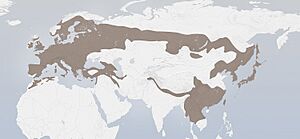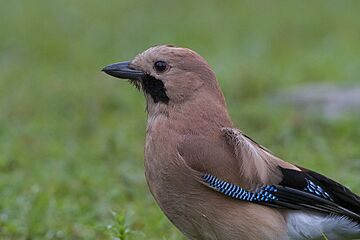Eurasian jay facts for kids
Quick facts for kids Eurasian jay |
|
|---|---|
 |
|
| Nominate subspecies in Belgium | |
| Conservation status | |
| Scientific classification | |
| Genus: |
Garrulus
|
| Species: |
glandarius
|
| Subspecies | |
|
33 (in eight groups) - see text |
|
 |
|
| Range | |
| Synonyms | |
|
|
The Eurasian jay (Garrulus glandarius) is a colorful bird from the crow family called Corvidae. It has pretty pinkish-brown feathers, a black stripe on its throat, and a bright blue patch on its wings. Its tail is black. This bird lives in woodlands across a huge area, from Europe and North Africa all the way to Asia. Because it lives in so many different places, there are many types of Eurasian jays that look a bit different from each other! In Great Britain and Ireland, people often just call it a "jay."
Contents
About the Eurasian Jay
Naming the Jay
The Eurasian jay was first officially described by a Swedish scientist named Carl Linnaeus in 1758. He gave it the scientific name Corvus glandarius. Later, it was moved to its own group, or genus, called Garrulus. The name Garrulus is a Latin word that means "chatty" or "noisy," which fits the jay's loud calls. The word glandarius means "of acorns," because jays love acorns!
Different Types of Jays
Across its huge home range, the Eurasian jay has many different forms, called subspecies. There are 33 known subspecies, grouped into eight main types. These different types can look quite distinct, especially if you compare jays from one end of their range to the other. For example, some have streaked heads, while others have black caps or white faces.
Some scientists even think that two of these groups are actually separate species. The white-face jay (Garrulus leucotis) and the plain-crowned jay (Garrulus bispecularis) are sometimes considered different species by groups like the International Union for Conservation of Nature (IUCN).
-
A plain-crowned jay (G. g. bispecularis) in Uttarakhand, India.
-
An atricapillus jay (G. g. atricapillus) in Jerusalem, Israel.
What Does a Jay Look Like?
The Eurasian jay is a medium-sized bird, similar to a western jackdaw. It is about 34 to 35 centimeters (13-14 inches) long, and its wings can spread out 52 to 58 centimeters (20-23 inches).
Most Eurasian jays have a light reddish-brown body. They have a white throat with a clear black stripe on each side, like a mustache. Their forehead and the top of their head are whitish with black stripes. The lower back (rump) is white. One of the most striking features is the bright blue patch on their upper wing, which has fine black stripes. Their tail is mostly black.
Jay Calls and Sounds
The most common sound a jay makes is a loud, harsh screech. They use this call to warn others when they see predators, like hawks. Jays are also amazing at copying other sounds! They can imitate the calls of many different birds, even birds of prey like the common buzzard. Sometimes, it's hard to tell if it's a real buzzard or just a jay playing a trick!
Where Jays Live and What They Do
Habitat and Home
Eurasian jays live in mixed woodlands, especially those with oak trees. They are famous for collecting and hiding acorns. In recent years, some jays have started moving into towns and cities. This might be because their woodland homes are shrinking.
Jays are very important for spreading oak trees. Before people started planting trees everywhere, jays were the main way oak trees spread. Each jay can hide over a thousand acorns every year! They have even helped spread holm oak trees in places like the Isle of Wight in Northern Europe. Jays can carry acorns as far as 20 kilometers (12 miles). They are even given credit for helping oaks spread quickly after the last ice age.
Life Cycle and Behavior
Reproduction and Family Life
Eurasian jays usually start having babies when they are two years old, though sometimes they can start at one year. Both the male and female jay help build the nest. They usually place it in a tree, often close to the main trunk, about 2 to 5 meters (6-16 feet) off the ground. Sometimes, they might even build a nest on a building.
The nest is made of twigs, with thinner twigs, roots, grass, and leaves inside. The female lays 3 to 6 eggs, usually one each morning. The eggs are pale green or olive-brown with small, darker spots. They might also have brown or black streaks. Each egg is about 31 mm long and weighs around 8.5 grams.
The female jay sits on the eggs to keep them warm, and they hatch after 16 to 19 days. While she is on the nest, the male brings her food. Once the babies hatch, both parents feed and care for them. The young jays leave the nest after 19 to 23 days, but their parents continue to feed them until they are 6 to 8 weeks old. Jays usually raise only one group of babies each year.
The oldest recorded Eurasian jay lived to be 16 years and 9 months old!
What Jays Eat
Jays find food both in trees and on the ground. They eat many different things! Their diet includes insects, especially pest insects. They love acorns (oak seeds), which they bury to eat later in winter. They also eat beech nuts, other seeds, and fruits like blackberries and rowan berries. Sometimes, they will eat young birds, eggs, bats, and small rodents.
Like most animals, a jay's diet changes with the seasons. But they are famous for hiding a lot of food, especially acorns and beechnuts, for winter and spring. They hide food all year, but they do it most often in the autumn.
Staying Healthy
Jays have a clever way to keep their feathers clean and free from tiny bugs called parasites. They will lie on top of anthills with their wings spread out. The ants then spray their feathers with a special liquid called formic acid, which helps get rid of the parasites! This behavior is called "anting."
Jay Intelligence
Like other birds in the crow family, Eurasian jays are quite smart. They have been seen planning for their future needs, like hiding food for later. Male jays also seem to understand what their partner wants when they share food during courtship. They are also good at protecting their hidden food from other jays who might try to steal it.









